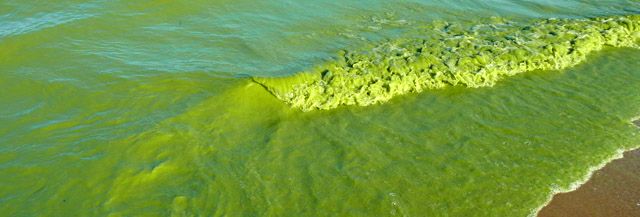If you are an American citizen and you follow the news, you probably heard about an algae outbreak in Lake Erie this past summer. If you found yourself in northwest Ohio, you were most certainly aware, because it directly affected your drinking water supply. For Ohio, this was unprecedented. Turning off the taps because of an algae growth simply had not been done before.
Why did this happen? What is the threat? Will it happen again? We are going to answer all of these questions.
Why are we seeing algal blooms?
Algal blooms are produced by the cyanobacteria species of algae. This species is commonly referred to as blue-green algae. Access to warm water, sunlight and importantly, nutrients, determines whether this kind of algae flourishes or not. The current problem in the US stems from high water temperatures and excessive nutrients. Specifically, fertilizer runoff from farming operations is finding its way into large bodies of water, such as Lake Erie, and providing the nutrients that this species of algae needs to thrive.
Why is the algae harmful?
The algae itself is not harmful. However, the algae releases toxins during several phases of its growth cycle. In addition, when the algae dies, toxins stored in the cell wall are released, making their way into the water.
Why can’t water treatment facilities handle these toxins
Yes, this is a problem. Earlier this year, residents of Toledo, Ohio, had no drinking water for a period of days after tests revealed abnormally high levels of algae-produced toxins in the water supply (see here.
Why couldn’t they do anything about it? As stated by the EPA, most of the water treatment facilities were built shortly after WWII, and the primary aim was to eliminate particulate matter. Disinfectant like chlorine is then used to neutralize harmful bacteria and other microorganisms. However, this system does not address toxins that have integrated into the water. The problem is that extracting toxins is costly, difficult and it may lead to other hazardous situations involving dangerous chemicals.
What can you do about it
Unfortunately, there is not a whole lot that you can do about this situation. If you drink tap water, you should certainly be filtering it and using some kind of purification system (we discuss multiple such systems on this site). But even some of these devices may not be effective during an outbreak of algal blooms. As an alternative — one that will also have other health benefits — consider drinking spring water.
No, spring water does not mean that you have to buy bottled water all the time. Check out our previous post on finding spring water for more on this. You may even be able to use some of the resources on that page to find a natural spring near you that offers free or low-cost refills.
The problem of algal blooms is likely going to get worse before it gets better. Rising temperatures of large water bodies will only contribute to the outbreaks, and environmental agencies are currently limited in their capacity to deal with this problem. As with many other environmental concerns, we are behind the curve, trying to catch up. As a consumer, you need to look out for yourself and your family, and in this case, that may mean depending on other means for acquiring your drinking water.
As always, feel free to share your thoughts in the comments below.







{ 0 comments… add one }